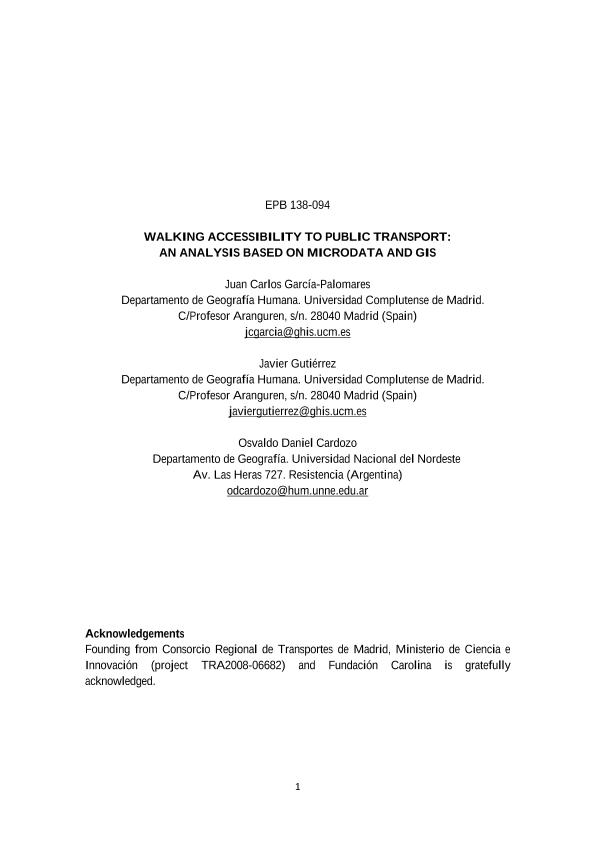Mostrar el registro sencillo del ítem
dc.contributor.author
García Palomares, Juan Carlos
dc.contributor.author
Gutiérrez Puebla, Javier
dc.contributor.author
Cardozo, Osvaldo Daniel

dc.date.available
2016-12-01T18:06:25Z
dc.date.issued
2013-05
dc.identifier.citation
García Palomares, Juan Carlos; Gutiérrez Puebla, Javier; Cardozo, Osvaldo Daniel; Walking accessibility to public transport: an analysis based on microdata and GIS; Pion Ltd; Environment and Planning B: Planning and Design; 40; 6; 5-2013; 1087-1102
dc.identifier.issn
0265-8135
dc.identifier.uri
http://hdl.handle.net/11336/8592
dc.description.abstract
In this paper we analyse the role of walking accessibility to transit facilities. Microdata and GIS tools have been used to calculate distances walked by different population groups in accessing Metro stations. Distances walked by the population were used to determine the threshold distances of the station service areas and calculate the population covered by the Metro network. With respect to Metro ridership, different distance-decay functions were adjusted and the sensitivity of the population groups to the distance was measured. Two indicators were proposed, based on the distance-decay functions, to measure access quality and potential demand. The Madrid Metro network was used as the study area. Results show that young people and adults, men, immigrants, and public transit captives are willing to walk longer distances and are less sensitive to the effect of distance. When walking distances have been used in order to fix the limit of catchment areas, the amount of the population covered is lower than when a standard threshold (0.5 miles) is used, but overestimations affect each age group in a different way. The access quality indicator shows that the population group in the worst situation is children and that stations in the centre of the network have higher access quality values. However, the synthetic accessibility indicator shows that potential demand is lower for the most central and most peripheral stations than for the stations located in the intermediate areas. It has been proved that both indicators are sensitive to changes in the spatial distribution of population groups within the catchment areas. These results demonstrate some of the advantages of the proposed methodology and argue in favour of its use in public transport planning.
dc.format
application/pdf
dc.language.iso
eng
dc.publisher
Pion Ltd

dc.rights
info:eu-repo/semantics/openAccess
dc.rights.uri
https://creativecommons.org/licenses/by-nc-sa/2.5/ar/
dc.subject
Accessibility
dc.subject
Walking Distance
dc.subject
Coverage Analysis
dc.subject
Distance-Decay Functions
dc.subject
Geographic Information Systems
dc.subject.classification
Estudios Urbanos

dc.subject.classification
Geografía Económica y Social

dc.subject.classification
CIENCIAS SOCIALES

dc.title
Walking accessibility to public transport: an analysis based on microdata and GIS
dc.type
info:eu-repo/semantics/article
dc.type
info:ar-repo/semantics/artículo
dc.type
info:eu-repo/semantics/publishedVersion
dc.date.updated
2016-11-23T18:17:08Z
dc.identifier.eissn
1472-3417
dc.journal.volume
40
dc.journal.number
6
dc.journal.pagination
1087-1102
dc.journal.pais
Reino Unido

dc.journal.ciudad
Londres
dc.description.fil
Fil: García Palomares, Juan Carlos. Universidad Complutense de Madrid; España
dc.description.fil
Fil: Gutiérrez Puebla, Javier. Universidad Complutense de Madrid; España
dc.description.fil
Fil: Cardozo, Osvaldo Daniel. Universidad Nacional del Nordeste. Facultad de Humanidades; Argentina. Consejo Nacional de Investigaciones Científicas y Técnicas; Argentina
dc.journal.title
Environment and Planning B: Planning and Design
dc.relation.alternativeid
info:eu-repo/semantics/altIdentifier/url/http://dx.doi.org/10.1068/b39008
dc.relation.alternativeid
info:eu-repo/semantics/altIdentifier/url/http://epb.sagepub.com/content/40/6/1087.short
Archivos asociados
